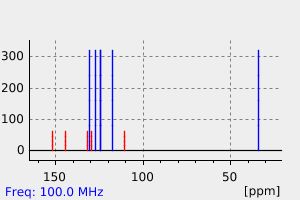6,6'-di-isopropyl-2,2'-di-hydroxy-1,1'-binaphthyl | 133376-98-4
中文名称
——
中文别名
——
英文名称
6,6'-di-isopropyl-2,2'-di-hydroxy-1,1'-binaphthyl
英文别名
(rac)‐6,6'‐diisopropyl‐[1,1'‐binaphthalene]‐2,2'‐diol;1-(2-Hydroxy-6-propan-2-ylnaphthalen-1-yl)-6-propan-2-ylnaphthalen-2-ol
CAS
133376-98-4
化学式
C26H26O2
mdl
——
分子量
370.491
InChiKey
NZGWXNDBABNBGK-UHFFFAOYSA-N
BEILSTEIN
——
EINECS
——
-
物化性质
-
计算性质
-
ADMET
-
安全信息
-
SDS
-
制备方法与用途
-
上下游信息
-
文献信息
-
表征谱图
-
同类化合物
-
相关功能分类
-
相关结构分类
计算性质
-
辛醇/水分配系数(LogP):7.6
-
重原子数:28
-
可旋转键数:3
-
环数:4.0
-
sp3杂化的碳原子比例:0.23
-
拓扑面积:40.5
-
氢给体数:2
-
氢受体数:2
上下游信息
-
上游原料
中文名称 英文名称 CAS号 化学式 分子量 —— (S)-6,6'-dibromo-1,1'-binaphthalene-2,2'-diol 79082-80-7 C20H12Br2O2 444.122
反应信息
-
作为反应物:描述:6,6'-di-isopropyl-2,2'-di-hydroxy-1,1'-binaphthyl 在 oxone||potassium monopersulfate triple salt 、 碳酸氢钠 作用下, 以 水 、 丙酮 为溶剂, 反应 2.0h, 以58%的产率得到(6aR*,13cS*)‐3,11‐diisopropyldinaphtho[2,1‐b:1',2'‐d]furan‐6a,13c‐diol参考文献:名称:在温和条件下,用环氧酮对轴向手性二元醇进行氧化脱芳香化后的手性转移。摘要:容易获得的轴向手性取代的二元醇(95至> 99%ee)在温和的条件下用Oxone / NaHCO 3 /丙酮体系进行氧化脱芳香化过程,得到五环半缩醛顺式二醇(94至> 99%ee),通过有效的轴向向中心手性传递,建立了两个新的立体生成中心。DOI:10.1021/acs.orglett.0c02194
-
作为产物:描述:6-溴-2-萘酚 在 iron(III) chloride 、 1,1'-双(二苯膦基)二茂铁二氯化钯(II)二氯甲烷复合物 、 二叔丁基过氧化物 作用下, 以 四氢呋喃 、 1,2-二氯乙烷 为溶剂, 反应 4.0h, 生成 6,6'-di-isopropyl-2,2'-di-hydroxy-1,1'-binaphthyl参考文献:名称:手性磷酸铁配合物催化2-萘酚的对映选择性氧化均偶联和交叉偶联摘要:制备了新型手性磷酸铁配合物作为不对称氧化偶联反应的催化剂。这些催化剂用于合成富含对映体的 C1 和 C2 对称 BINOL,其中 3 和 3' 位置可用于化学修饰。有人提出该反应是通过氧化自由基 - 阴离子偶联机制发生的。揭示了与 2-萘酚的对映选择性氧化偶联竞争的破坏性 BINOL 外消旋化,从而为这一非常重要的反应提供了新的见解。DOI:10.1021/jacs.6b11198
文献信息
-
The quincyte pigments: Fossil quinones in an eocene clay mineral作者:William G. Prowse、Katherine I. Arnot、Josef A. Recka、Ronald H. Thomson、James R. MaxwellDOI:10.1016/s0040-4020(01)80947-9日期:1991.1An unusual series of quinone pigments in a pink Eocene (c. 45x10(6) yr) sepiolite (quincyte, France) has been characterised by spectroscopy. The structure of the major pigment (c. 75% of total), 2,8-di-isopropyl-peri-xanthenoxanthene-4,10-quinone, was confirmed by synthesis. Spectroscopy revealed six minor related components with various oxygenated C-2 substituents (C1-C3) and, generally, a C-8 isopropyl group. Although the origin of the pigments is unknown, they (or their precursors) appear to have been biosynthesised by the acyl-malonate pathway.
表征谱图
-
氢谱1HNMR
-
质谱MS
-
碳谱13CNMR
-
红外IR
-
拉曼Raman
-
峰位数据
-
峰位匹配
-
表征信息
同类化合物
(S)-溴烯醇内酯
(R)-3,3''-双([[1,1''-联苯]-4-基)-[1,1''-联萘]-2,2''-二醇
(3S,3aR)-2-(3-氯-4-氰基苯基)-3-环戊基-3,3a,4,5-四氢-2H-苯并[g]吲唑-7-羧酸
(3R,3’’R,4S,4’’S,11bS,11’’bS)-(+)-4,4’’-二叔丁基-4,4’’,5,5’’-四氢-3,3’’-联-3H-二萘酚[2,1-c:1’’,2’’-e]膦(S)-BINAPINE
(11bS)-2,6-双(3,5-二甲基苯基)-4-羟基-4-氧化物-萘并[2,1-d:1'',2''-f][1,3,2]二氧磷
(11bS)-2,6-双(3,5-二氯苯基)-4羟基-4-氧-二萘并[2,1-d:1'',2''-f][1,3,2]二氧磷杂七环
(11bR)-2,6-双[3,5-双(1,1-二甲基乙基)苯基]-4-羟基-4-氧化物-二萘并[2,1-d:1'',2''-f][1,3,2]二氧杂磷平
黄胺酸
马兜铃对酮
马休黄钠盐一水合物
马休黄
食品黄6号
食品红40铝盐色淀
飞龙掌血香豆醌
颜料黄101
颜料红70
颜料红63
颜料红53:3
颜料红5
颜料红48单钠盐
颜料红48:2
颜料红4
颜料红261
颜料红258
颜料红220
颜料红22
颜料红214
颜料红2
颜料红19
颜料红185
颜料红184
颜料红170
颜料红148
颜料红147
颜料红146
颜料红119
颜料红114
颜料红 9
颜料红 21
颜料橙7
颜料橙46
颜料橙38
颜料橙3
颜料橙22
颜料橙2
颜料橙17
颜料橙 5
颜料棕1
顺式-阿托伐醌-d5
雄甾烷-3,17-二酮







